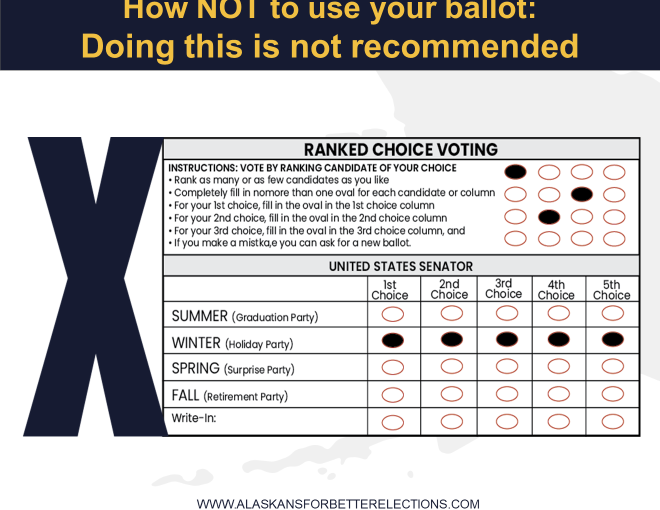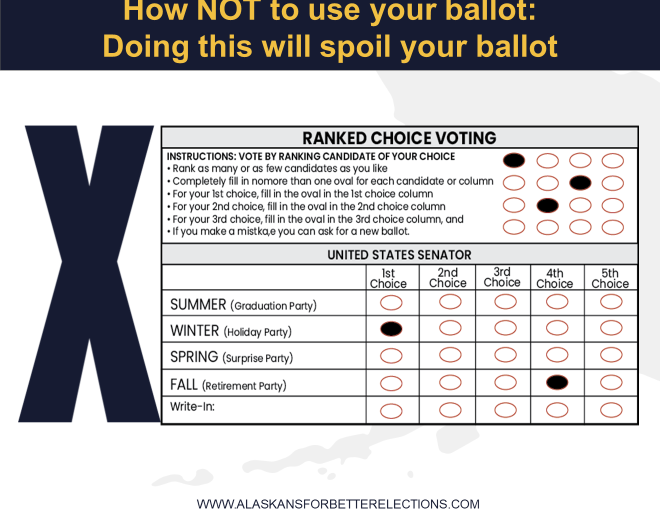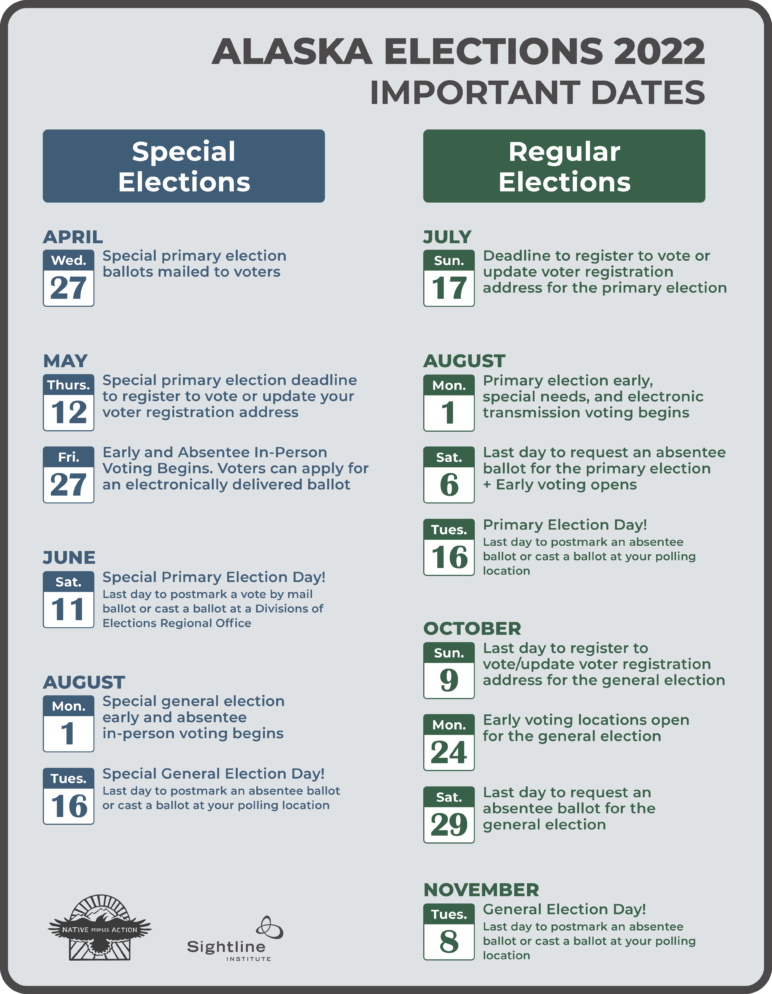Author’s note: I’ll be updating this article regularly with new information and additional questions we hear from readers. As noted below, I invite questions in the comments section, by email, and on Twitter.
Find information on Alaska's August 16, 2022, election by clicking here.
Alaska’s special election is special indeed: The winner will temporarily fill the US House seat of the late Representative Don Young. A new voting system of open primaries and ranked choice general elections will make its debut. And in the special primary, Alaska will hold its first statewide mail-in election.
The special election gives Alaska voters a chance to test-drive their new approach to picking political leaders. In the primary election, all candidates will appear on a single ballot. The top four voter-getters will then advance to the general election ballot, where voters can rank them from most- to least-favorite. The same system will apply to the regular election later this year, when Alaskans will decide races for legislature, governor, US Senate, and the full two-year term for the House seat.
The combination of open primary and ranked choice general elections promises to help tamp down extreme partisanship, encourage cooperation between candidates, and let voters choose their true favorites rather than candidates they merely tolerate.
Below we answer the top questions we’ve been hearing about Alaska’s special election:
- Basic info on the special election
- How to vote in the special election
Sightline Institute is also producing and sharing free voter education resources for Alaska at sightline.org/AlaskaVote, including graphics detailing key election dates, sample ballots, and a map of regional election offices. If you still have questions after reviewing the ones below, I invite you to email me or ask me on Twitter.
What is the special election and why is it happening?
In March 2022, huge news swept the state: Alaska’s only member of the US House of Representatives, the pugnacious 88-year-old Congressman Don Young, had passed away. The US Constitution requires an election to fill a vacant US House seat.
Until Alaskans select a replacement for Young, they will have no voting member in the House. The office is still open and Alaskans can still get in touch, but without a representative in the seat, the Anchorage Daily News explains, “the office cannot introduce or cosponsor bills, nor can it advocate for bills that Young introduced or cosponsored before his death, though those bills can still be considered by the House.” The winner of the special election will serve in Congress from September through the end of Young’s term in January 2023. After that, the winner of the state’s regular election will assume the seat.
Who are the candidates running in the special election?
An eclectic slate of 48 candidates is running in the special primary election. You can find their names on a sample ballot from the Alaska Division of Elections. Only 4 will advance from the special primary to the special general election.
How do I learn more about the candidates?
The Division of Elections has compiled a full list of candidates, along with their contact information and campaign websites.
The Anchorage Daily News has gathered information on where the candidates stand on various issues, their top priorities, why they’re running, and what makes them qualified.
What are the key dates for the special election?
The special election will take place in two parts.
First, there will be a special primary election to narrow the field to four candidates. Voters must mail in their special primary election ballots with a postmark date on or before Saturday, June 11. (Limited options for early and absentee-in-person voting open on Friday, May 27.)
The special general election takes place on Tuesday, August 16. Important: This will happen on the same day as the regular primary election.
We made a free timeline of all of Alaska’s key 2022 election dates. It’s printable and social media-shareable. You could use it in a PowerPoint, or turn it into a fridge magnet, flyer, or poster.
The key dates for the special election are:
- Wednesday, April 27: Special election ballots are mailed to voters
- Thursday, May 12: Special election deadline to register to vote or update your voter registration address
- Friday, May 27: Special election early and absentee in-person voting begins
- Saturday, June 11: Special primary election day! This is the last day to postmark a vote by mail ballot or cast a ballot at a Division of Elections Regional Office (see map below or download it from this page).
- Tuesday, August 16: Special general election day! This is the last day to postmark a vote by mail ballot or cast a ballot at a Division of Elections Regional Office (see map below or download it from this page).
- Friday, September 2: Alaskans will learn the winner of the special election when the Alaska Division of Elections certifies the results.
How long will the winner serve in office?
The winner of the special election will serve from September 2022 through January 2023, when Young’s two-year term was scheduled to end.
The winner of the regular midterm election will assume Alaska’s House seat in January 2023. They could be the same person who won the special election if that individual also runs in the regular election, or they could be someone else.
How to vote in Alaska’s 2022 special election
How do I register to vote in the special election?
If you are an eligible voter in Alaska and applied for a Permanent Fund Dividend in 2021, you were automatically registered to vote. To check your voter registration status, go to the state’s My Voter Information page.
If you need to register or change your voter information, visit the state’s Online Voter Registration page. The deadline to register for the special primary election is Thursday, May 12. If you miss that (but don’t!), the deadline to register for the special general election is Sunday, July 17.
 Where can I get ballots for the special primary and special general elections?
Where can I get ballots for the special primary and special general elections?
Special primary election (vote by mail, mostly)
The unexpected timing of the special election meant that the Alaska Division of Elections had to set it up on short notice with a smaller staff than usual because of the pandemic. Since vote by mail elections require fewer poll workers and other personnel, the division chose that option over an in-person election. Fortunately, voters in Anchorage, who make up close to 40 percent of registered voters, are already accustomed to vote by mail elections.
All eligible voters will receive their special primary ballot and a postage-paid return envelope in the mail from the Alaska Division of Elections. The division mailed out ballots on Wednesday, April 27.
The state is also allowing for absentee early and in-person voting in dozens of communities. This is an important option in particular for rural communities with inconsistent mail service.
Special general election
Voting reverts to normal options for the special general election. Voters who wish to vote by mail must request an absentee ballot. They can also vote in person either early or on Election Day.
The special general election will occur on the same day as the regular primary election. Both sets of races will appear on the same ballot. That means voters will be ranking candidates to temporarily fill the US House seat for the remainder of Young’s term. At the same time, they’ll be voting in open primaries for legislature, governor, US Senate, and the full two-year term for the US House seat.
Ballot tracking
Sign up for ballot tracking to follow your mail-in special primary ballot through the voting process. You’ll get updates by text and/or email. It’s a lot like tracking an item you’ve ordered online.
How can voters request election materials or learn more about the special election in a language other than English?
In Alaska, voters can obtain election materials and help from translators either in person or by phone in a variety of languages. The Division of Elections is communicating with voters statewide in Alaska Native languages, Spanish, Tagalog, and other languages required for Alaska by federal law. Posters, brochures, radio spots, and other translated voter information will be available as the year goes on, according to the division’s language compliance manager Samantha Mack.
In writing
Voter registration applications: Available in Tagalog, Spanish, six Yup’ik languages (General Central Yup’ik, Norton Sound Kotlik Yup’ik, Yukon Yup’ik, Hooper Bay Yup’ik, Bristol Bay Yup’ik, Chevak Cup’ik) and Nunivak Cup’ig. Gwich’in will be available soon as well.
Absentee ballot applications: Available in Tagalog, Spanish, and General Central Yup’ik.
Sample ballots: Available in Tagalog, Spanish, six Yup’ik languages (see above), Nunivak Cup’ig, Gwich’in, Inupiaq (Northern/Seward Peninsula), and Unangam Tunuu.
Real ballots: The actual ballots will all be in English. In precincts with electronic voting tablets, translated audio is typically available in Spanish, Tagalog, six Yup’ik languages (see above), Nunivak Cup’ig, Gwich’in, and Inupiaq. Voters are allowed to use sample ballots as an aid.
Official election pamphlets: Available in Tagalog and Alaska Native languages. For the first time, the division will mail the Alaska Native language versions of the pamphlets direct to voter households this year, in addition to the usual household mailings of the Tagalog version. The division for the first time will also allow voters to bring the pamphlets to polling places. Digital versions of the pamphlet in Spanish will be available on the division’s website.
Election glossaries: The division is issuing updated elections glossaries for all Yup’ik languages as well as Gwich’in. The update includes terms and phrases related to ranked choice voting and the new top four primary system. An Unangam Tunuu elections glossary is in the works.
Nonpartisan top four primary and ranked choice voting FAQ: Available online in six Yup’ik languages, Spanish, Tagalog. Nunivak Cup’ig and Gwich’in as soon as they are completed.
PowerPoint presentation: The division is translating a printable PowerPoint presentation about the new election system into all languages typically provided by the division.
In Person
On election days (primary and general), on-call interpreters and bilingual registrars, outreach workers, and poll workers will be available in certain communities based on the availability of poll and outreach workers.1
Voters may have a person of their choice provide assistance as long as that person is not a candidate, their employer, an agent of their employer, or an agent of their union. The voter’s assistant may go into the voting booth to help the voter cast their ballot.
By phone
Voters may call a toll-free language assistance number on or before Election Day: (866) 954-8683 or (907) 275-2333.
Radio
Public service announcements are airing in Tagalog, Spanish, six Yup’ik languages, and Gwich’in, and the division is working on more in Inupiaq and Unangam Tunuu. The PSAs cover registration deadlines, candidate deadlines, list maintenance, accessibility assistance, availability of the Official Election Pamphlet, the dates of elections, and when voting will occur.
By mail
The division is sending translated mailers direct to voter households and to tribal councils2 on the changes to the upcoming primary and general election, the special election, instructions for voting their absentee by-mail ballot, and other information. Tribal councils will also receive messages they can post to their community boards and copies of translated voter registration applications.
Videos
The division has translated educational videos about the new election system on its website and YouTube. The division plans to share the videos on social media in conjunction with Alaska Native regional corporations and other community organizations, including Get Out the Native Vote.
Mock elections
Alaska’s mock election educational tool, including detailed results and explainers, is available in more than two dozen languages, including several Alaska Native dialects.
How do I fill out my ballot correctly?
In the primary election, all 48 candidates will appear on a single ballot. The top four voter-getters will then advance to the general election ballot, where voters can rank them from most- to least-favorite.
Special primary election (pick one)
Voters will select their one favorite candidate from the list of several dozen candidates. They must then a) seal the ballot in the accompanying return envelope, b) sign the return envelope, c) find a witness to sign the return envelope, and d) mail the envelope back to the elections division.

A mock primary ballot, designed by Sightline Institute, for Alaskans to vote their favorite Alaskan highway. In the primary, voters vote for just one option, and the top four vote-getters advance to the ranked choice general election.
Special general election (rank the candidates)
Voters will receive a ballot with the four winners of the special primary election listed. Voters will then rank those candidates in their order of preference for Congressman Young’s seat. For more on how ranked choice ballots are counted and the winner determined, see this video.
Note: The special general and the regular primary elections occur on the same day (August 16) and will appear on the same ballot.

A mock general election ballot, designed by Sightline Institute, for Alaskans to vote their favorite Alaskan highway. This ranked choice general election ballot lists the top four vote-getters from the primary ballot above, and voters now rank them in order of preference.
What are some common mistakes to avoid when filling out a ranked choice ballot in the general election?
Filling out your ranked choice ballot the wrong way means you risk spoiling your special general election ballot. Your vote either won’t count or you’ll end up effectively voting for just one candidate, rather than having your votes redistributed to your next-favorite candidate(s).
• Do not rank a candidate more than once. Your vote will not count for that candidate more than once.

• Don’t give more than one candidate the same ranking.

• Don’t skip rankings.

Replacing a lost ballot
Lost your ballot? Contact any Division of Elections office to request a replacement ballot for the special primary election. The deadline to replace a lost primary ballot is June 1. You can also request a new ballot be delivered electronically by June 10 at 5 p.m.
What’s next?
Go vote!










Karin Stilson
I know my ballot was mailed but it hasn’t arrived yet. I’m getting concerned that it may have been stolen from the mailbox. Can I get a replacement ballot requested and who do I ask? Karin Stilson, North Pole AK
Jeannette Lee
Karin,
The Division of Elections home page says to “contact any office to request a replacement ballot for the special primary election.”
Here is the link to the various offices you can contact: https://www.elections.alaska.gov/Core/contactusandsitemap.php
You might start with your Regional office before trying the Absentee and Petition office and the Director’s office: